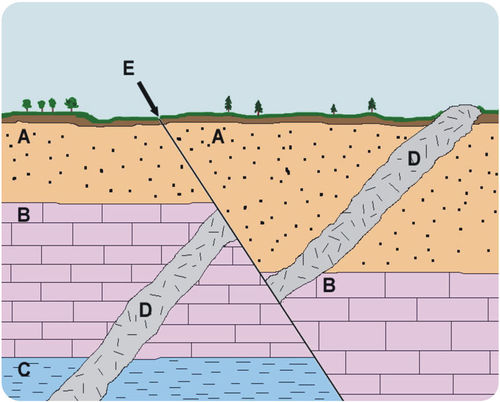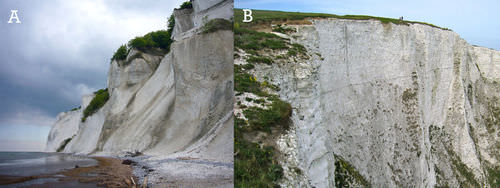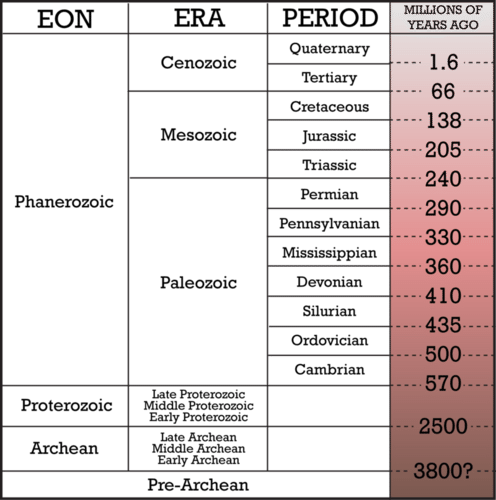11.2 Relative Ages of Rocks
11.2 Relative Ages of Rocks
Lesson Objectives
- Explain how stratigraphy can be used to determine the relative ages of rocks.
- State how unconformities occur.
- Identify ways to match rock layers in different areas.
- Describe how Earth’s history can be represented by the geologic time scale.
Vocabulary
- geologic time scale
- key bed
- law of superposition
- relative age
- stratigraphy
- unconformity
Introduction
The way things happen now is the same way things happened in the past. Earth processes have not changed over time. Mountains grow and mountains slowly wear away, just as they did billions of years ago. As the environment changes, living creatures adapt. They change over time. Some organisms may not be able to adapt. They become extinct, meaning that they die out completely.
Historical geologists study the Earth’s past. They use clues from rocks and fossils to figure out the order of events. They think about how long it took for those events to happen.
Laws of Stratigraphy
The study of rock strata is called stratigraphy. The laws of stratigraphy can help scientists understand Earth’s past. The laws of stratigraphy are usually credited to a geologist from Denmark named Nicolas Steno. He lived in the 1600s. The laws are illustrated in Figure below. Refer to the figure as you read about the laws below.
Laws of Stratigraphy. This diagram illustrates the laws of stratigraphy. A = Law of Superposition, B = Law of Lateral Continuity, C = Law of Original Horizontality, D = Law of Cross-Cutting Relationships
Law of Superposition
Superposition refers to the position of rock layers and their relative ages. Relative age means age in comparison with other rocks, either younger or older. The relative ages of rocks are important for understanding Earth’s history. New rock layers are always deposited on top of existing rock layers. Therefore, deeper layers must be older than layers closer to the surface. This is the law of superposition. You can see an example in Figure below.
Superposition. The rock layers at the bottom of this cliff are much older than those at the top. What force eroded the rocks and exposed the layers?
Law of Lateral Continuity
Rock layers extend laterally, or out to the sides. They may cover very broad areas, especially if they formed at the bottom of ancient seas. Erosion may have worn away some of the rock, but layers on either side of eroded areas will still “match up.”
Look at the Grand Canyon in Figure below. It’s a good example of lateral continuity. You can clearly see the same rock layers on opposite sides of the canyon. The matching rock layers were deposited at the same time, so they are the same age.
Lateral Continuity. Layers of the same rock type are found across canyons at the Grand Canyon.
Law of Original Horizontality
Sediments were deposited in ancient seas in horizontal, or flat, layers. If sedimentary rock layers are tilted, they must have moved after they were deposited.
Law of Cross-Cutting Relationships
Rock layers may have another rock cutting across them, like the igneous rock in Figure below. Which rock is older? To determine this, we use the law of cross-cutting relationships. The cut rock layers are older than the rock that cuts across them.
Cross-cutting relationships in rock layers. Rock D is a dike that cuts across all the other rocks. Is it older or younger than the other rocks?
Unconformities
Geologists can learn a lot about Earth’s history by studying sedimentary rock layers. But in some places, there’s a gap in time when no rock layers are present. A gap in the sequence of rock layers is called an unconformity.
Look at the rock layers in Figure below. They show a feature called Hutton’s unconformity. The unconformity was discovered by James Hutton in the 1700s. Hutton saw that the lower rock layers are very old. The upper layers are much younger. There are no layers in between the ancient and recent layers. Hutton thought that the intermediate rock layers eroded away before the more recent rock layers were deposited.
Hutton's discovery was a very important event in geology! Hutton determined that the rocks were deposited over time. Some were eroded away. Hutton knew that deposition and erosion are very slow. He realized that for both to occur would take an extremely long time. This made him realize that Earth must be much older than people thought. This was a really big discovery! It meant there was enough time for life to evolve gradually.
Hutton's unconformity, in Scotland.
Matching Rock Layers
When rock layers are in the same place, it’s easy to give them relative ages. But what if rock layers are far apart? What if they are on different continents? What evidence is used to match rock layers in different places?
Widespread Rock Layers
Some rock layers extend over a very wide area. They may be found on more than one continent or in more than one country. For example, the famous White Cliffs of Dover are on the coast of southeastern England. These distinctive rocks are matched by similar white cliffs in France, Belgium, Holland, Germany, and Denmark (see Figure below). It is important that this chalk layer goes across the English Channel. The rock is so soft that the Channel Tunnel connecting England and France was carved into it!
Chalk Cliffs. (A) Matching chalk cliffs in Denmark and (B) in Dover, U.K.
Key Beds
Like index fossils, key beds are used to match rock layers. A key bed is a thin layer of rock. The rock must be unique and widespread. For example, a key bed from around the time that the dinosaurs went extinct is very important. A thin layer of clay was deposited over much of Earth’s surface. The clay has large amount of the element iridium. Iridium is rare on Earth but common in asteroids. This unusual clay layer has been used to match rock up layers all over the world. It also led to the hypothesis that a giant asteroid struck Earth and caused the dinosaurs to go extinct.
Using Index Fossils
Index fossils are commonly used to match rock layers in different places. You can see how this works in Figure below. If two rock layers have the same index fossils, then they’re probably about the same age.
Using Index Fossils to Match Rock Layers. Rock layers with the same index fossils must have formed at about the same time. The presence of more than one type of index fossil provides stronger evidence that rock layers are the same age.
The Geologic Time Scale
Earth formed 4.5 billion years ago. Geologists divide this time span into smaller periods. Many of the divisions mark major events in life history.
Dividing Geologic Time
Divisions in Earth history are recorded on the geologic time scale. For example, the Cretaceous ended when the dinosaurs went extinct. European geologists were the first to put together the geologic time scale. So, many of the names of the time periods are from places in Europe. The Jurassic Period is named for the Jura Mountains in France and Switzerland, for example.
Putting Events in Order
To create the geologic time scale, geologists correlated rock layers. Steno's laws were used to determine the relative ages of rocks. Older rocks are at the bottom and younger rocks are at the top. The early geologic time scale could only show the order of events. The discovery of radioactivity in the late 1800s changed that. Scientists could determine the exact age of some rocks in years. They assigned dates to the time scale divisions. For example, the Jurassic began about 200 million years ago. It lasted for about 55 million years.
Divisions of the Geologic Time Scale
The largest blocks of time on the geologic time scale are called “eons.” Eons are split into “eras.” Each era is divided into “periods.” Periods may be further divided into “epochs.” Geologists may just use “early” or “late.” An example is “late Jurassic,” or “early Cretaceous.” Figure below shows you what the geologic time scale looks like.
The Geologic Time Scale.
Life and the Geologic Time Scale
The geologic time scale may include illustrations of how life on Earth has changed. Major events on Earth may also be shown. These include the formation of the major mountains or the extinction of the dinosaurs. Figure below is a different kind of the geologic time scale. It shows how Earth’s environment and life forms have changed.
The evolution of life is shown on this spiral.
Your Place in Geologic Time
We now live in the Phanerozoic Eon, the Cenozoic Era, the Quaternary Period, and the Holocene Epoch. “Phanerozoic” means visible life. During this eon, rocks contain visible fossils. Before the Phanerozoic, life was microscopic. The Cenozoic Era means new life. It encompasses the most recent forms of life on Earth. The Cenozoic is sometimes called the Age of Mammals. Before the Cenozoic came the Mesozoic and Paleozoic. The Mesozoic means middle life. This is the age of reptiles, when dinosaurs ruled the planet. The Paleozoic is old life. Organisms like invertebrates and fish were the most common lifeforms.
Lesson Summary
- The study of rock layers is called stratigraphy. Laws of stratigraphy help scientists determine the relative ages of rocks. The main law is the law of superposition. This law states that deeper rock layers are older than layers closer to the surface.
- An unconformity is a gap in rock layers. They occur where older rock layers eroded away completely before new rock layers were deposited.
- Other clues help determine the relative ages of rocks in different places. They include key beds and index fossils.
- Scientists use the geologic time scale to illustrate the order in which events on Earth have happened.
- The geologic time scale was developed after scientists observed changes in the fossils going from oldest to youngest sedimentary rocks. They used relative dating to divide Earth’s past in several chunks of time when similar organisms were on Earth.
- The geologic time scale is divided into eons, eras, periods, and epochs.
Lesson Review Questions
Recall
1. Define stratigraphy.
2. What is the relative age of a rock?
3. State the law of superposition.
4. What are unconformities?
5. How do key beds help date rock layers?
Apply Concepts
6. Apply laws of stratigraphy to explain the rock formation below.

7. Which rock in the illustration below formed first, the igneous rock (A) or the sedimentary rock (B)? Apply lesson concepts to support your answer.
8. Why did early geologic time scales not include the number of years ago that events happened?
Think Critically
9. Use the law of lateral continuity to explain why the same rock layers are found on opposite sides of the Grand Canyon.
10. Dinosaurs went extinct about 66 million years ago. Which period of geologic time was the last in which dinosaurs lived?
11. Why are sedimentary rocks more useful than metamorphic or igneous rocks in establishing the relative ages of rock?
Points to Consider
In this lesson, you read how scientists determine the relative ages of sedimentary rock layers. The law of superposition determines which rock layers are younger or older than others.
- What about the actual ages of rocks? Is there a way to estimate their ages in years?
- And what about other kinds of rocks? For example, is there a way to estimate the ages of igneous rocks?
- Log in or register to post comments
- Email this page










